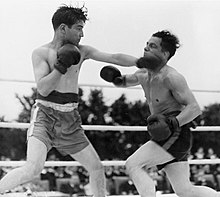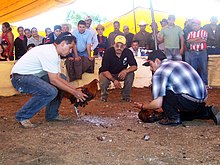
Cockfighting is a blood sport involving roosters ("cocks"), held in a ring called a cockpit. The first documented use of the word gamecock, denoting use of the cock as to a "game", a sport, pastime or entertainment, was recorded in 1634, after the term "cock of the game" used by George Wilson, in the earliest known book on the sport of cockfighting in The Commendation of Cocks and Cock Fighting in 1607. But it was during Magellan's voyage of discovery of the Philippines in 1521 when modern cockfighting was first witnessed and documented for Westerners by the Italian Antonio Pigafetta, Magellan's chronicler, in the Kingdom of Taytay.

Bull-baiting is a blood sport involving pitting a bull against dogs with the aim of attacking and subduing the bull by biting and holding onto its nose or neck, which often resulted in the death of the bull.
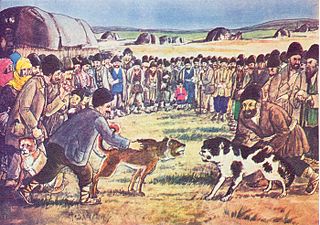
Dog fighting is a type of blood sport that turns game and fighting dogs against each other in a physical fight, often to the death, for the purposes of gambling or entertainment to the spectators. In rural areas, fights are often staged in barns or outdoor pits; in urban areas, fights are often staged in garages, basements, warehouses, alleyways, abandoned buildings, neighborhood playgrounds, or in the streets. Dog fights usually last until one dog is declared a winner, which occurs when one dog fails to scratch, dies, or jumps out of the pit. Sometimes dog fights end without declaring a winner; for instance, the dog's owner may call the fight.
The League Against Cruel Sports, formerly known as the League for the Prohibition of Cruel Sports, is a UK-based animal welfare charity which campaigns to stop blood sports such as fox hunting, hare and deer hunting; game bird shooting; and animal fighting. The charity helped bring about the Hunting Act 2004 and Protection of Wild Mammals (Scotland) Act 2002, which banned hunting with hounds in England, Wales and Scotland.

Cruelty to animals, also called animal abuse, animal neglect or animal cruelty, is the infliction of suffering or harm by humans upon non-human animals, either by omission (neglect) or by commission. More narrowly, it can be the causing of harm or suffering for specific achievements, such as killing animals for entertainment; cruelty to animals sometimes encompasses inflicting harm or suffering as an end in itself, referred to as zoosadism. Divergent approaches to laws concerning animal cruelty occur in different jurisdictions throughout the world. For example, some laws govern methods of killing animals for food, clothing, or other products, and other laws concern the keeping of animals for entertainment, education, research, or pets. There are several conceptual approaches to the issue of cruelty to animals.

Hare coursing is the pursuit of hares with greyhounds and other sighthounds, which chase the hare by sight, not by scent.
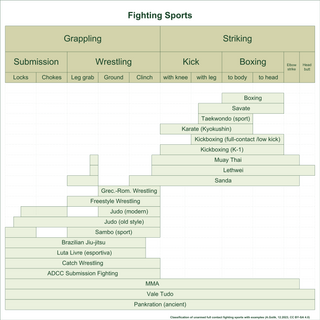
A combat sport, or fighting sport, is a contact sport that usually involves one-on-one combat. In many combat sports, a contestant wins by scoring more points than the opponent, submitting the opponent with a hold, disabling the opponent, or attacking the opponent in a specific or designated technique. Combat sports share a long history with the martial arts.

The Old English Bulldog is an extinct breed of dog.

Rat-baiting is a blood sport that involves releasing captured rats in an enclosed space with spectators betting on how long a dog, usually a terrier, takes to kill the rats. Often, two dogs competed, with the winner receiving a cash prize. It is now illegal in most countries.
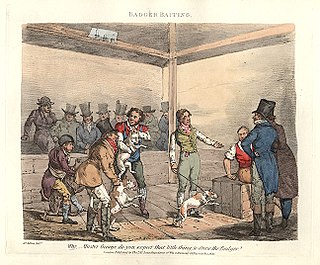
Badger-baiting is a form of blood sport in which badgers are baited with dogs. A baiting session typically results in the death of the badger, and possibly serious injuries to the dogs.

The Cruelty to Animals Act 1835 was an Act of the Parliament of the United Kingdom, intended to protect animals, and in particular cattle, from mistreatment. Its long title is An Act to Consolidate and Amend the Several Laws Relating to the Cruel and Improper Treatment of Animals, and the Mischiefs Arising from the Driving of Cattle, and to Make Other Provisions in Regard Thereto.

Animals in sport are a specific form of working animals. Many animals, at least in more commercial sports, are highly trained. Two of the most common animals in sport are horses and dogs.

Opposition to hunting is espoused by people or groups who object to the practice of hunting, often seeking anti-hunting legislation and sometimes taking on acts of civil disobedience, such as hunt sabotage. Anti-hunting laws, such as the English Hunting Act 2004, are generally distinguishable from conservation legislation like the American Marine Mammal Protection Act by whether they seek to reduce or prevent hunting for perceived cruelty-related reasons or to regulate hunting for conservation, although the boundaries of distinction are sometimes blurred in specific laws, for example when endangered animals are hunted.
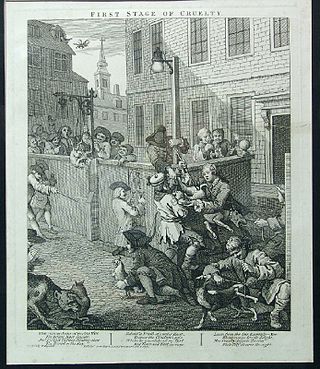
Cock throwing, also known as cock-shying or throwing at cocks, was a blood sport widely practised in England until the late 18th century. A rooster was tied to a post, and people took turns throwing coksteles at the bird until it died. Cock throwing was traditionally associated with Shrove Tuesday. A contributor to The Gentleman's Magazine in 1737, during an anti-Gallican phase of British culture, was of the opinion that cock throwing arose from traditional enmity towards the French, for which the cock played an emblematic role.
In the Elizabethan era (1558–1603), there was a wide range of leisure activities entertaining both the nobility and the common classes. Among these leisure activities were animal fighting, team sports, individual sports, games, dramatics, music and the arts.
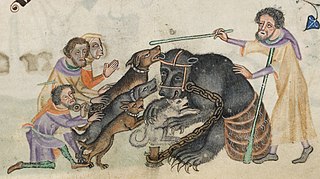
Bear-baiting is a blood sport in which a chained bear and one or more dogs are forced to fight one another. It may also involve pitting a bear against another animal. Until the 19th century, it was commonly performed in Great Britain, Sweden, India, Pakistan, and Mexico among others.
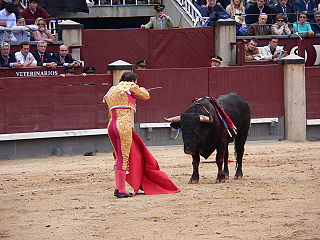
Bullfighting is a physical contest that involves a bullfighter attempting to subdue, immobilize, or kill a bull, usually according to a set of rules, guidelines, or cultural expectations.

Bull wrestling, cow fighting or bull fighting is a non-lethal human-facilitated bloodsport between bulls or cows found in some parts of the world.
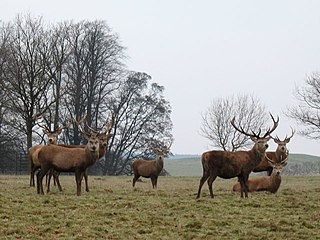
Animal welfare in the United Kingdom relates to the treatment of animals in fields such as agriculture, hunting, medical testing and the domestic ownership of animals. It is distinct from animal conservation.

The Gull Terrier is a rare breed of dog that originates from the Punjab region of Pakistan and India; it is believed to be several hundred years old. They are often used in dog fighting, hunting, and guarding. The Gull Terrier is a direct decendent of the Bull Terrier breed that came from Great Britain. These English dog breeds, along with those indigenous to the Indian subcontinent such as the Bully Kutta, played a major role in the Gull Terrier's breeding development and are considered to be a direct ancestor of the modern Gull Terrier. Old photographs of the English Bull terrier delineate many of the same features such as height pointy ears and a long muzzle of the Gull Terrier.
